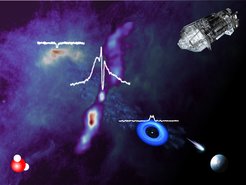Why our water is billions of years old
Long-awaited review reveals journey of water from interstellar clouds to habitable worlds
How and where water is formed in interstellar space and how it eventually ends up on a planet like Earth was not well understood ten years ago. One reason for this is that observations made with ground-based telescopes are affected by water vapour in our own atmosphere. In 2009, ESA launched the far-infrared space telescope Herschel, which was in service until 2013. One of Herschel’s main goals was to research water in space. In recent years, dozens of scientific articles have been published based on Herschel's water data. Now these results have been combined and expanded with new insights.

Journey of water from interstellar clouds to habitable worlds. From top left to bottom right: water in a cold interstellar cloud, near a young, forming star with an outflow, in a protoplanetary disc, in a comet and in the oceans of an exoplanet. The first three stages show the spectrum of water vapour measured by the HIFI instrument on the Herschel space observatory. The signals from the cold interstellar cloud and from the protoplanetary disk have been exaggerated in this image by a factor of 100 compared to those from the young, forming star in the centre.
The new study describes the journey of water throughout the star formation process, including the intermediate stages which, until now, had received less attention. Most of the water is formed as ice on tiny dust particles in cold and tenuous interstellar clouds prior to star formation, as shown in work led by MPE Director Paola Caselli. When a cloud collapses into new stars and planets, this water is largely preserved and quickly anchored into pebble-sized dust particles. In the rotating disc around the young star, these pebbles then form the building blocks for new planets.
Furthermore, the researchers have calculated that most new solar systems are born with enough water to fill several thousand oceans. Ewine van Dishoeck: "It's fascinating to realise that when you drink a glass of water, most of those molecules were made more than 4.5 billion years ago in the cloud from which our sun and the planets formed."
Many of the earlier Herschel results focused on the hot water vapour that is prominently seen and copiously produced near forming stars. But that hot water is lost to space by the powerful outflows from the young star. Whilst writing the review, the researchers gained more and more insight into the chemistry of the cold water vapour and ice. For example, they were able to show that interstellar ice grows on dust particles layer by layer. They based this conclusion on the weak signals from heavy water (HDO and D2O instead of H2O).
In the future, researchers hope to be able to study more water in the universe, particularly in forming planetary systems. However, that might take a while. The next space telescope comparable to Herschel is planned to launch no earlier than 2040. Ewine van Dishoeck: "There was a chance that a 'water telescope' would go into space around 2030, but that project was cancelled. That is a pity, but it was an extra reason for our team to write the water overview. In that way we have a collective memory for when a new mission comes along."
Moreover, at the end of 2021, the James Webb space telescope will be launched. It will contain the MIRI instrument, built by European-US partnership, which will be able to reveal a part of the water roadmap that has remained out of reach until now. MIRI will be able to detect warm water vapour in the innermost zones of dust disks. And the ALMA telescopes in Chile can observe water vapour in space from the ground. This includes water in distant galaxies where water can be observed at wavelengths that have shifted away from those in the Earth's atmosphere.
About the Herschel space telescope
Herschel was a space telescope of the European Space Agency (ESA) built in cooperation with the NASA. Its HIFI and PACS instruments were used for the water research. HIFI was designed and built by a consortium of institutes and university departments across Europe, Canada, and the United States under the leadership of SRON Netherlands Institute for Space Research, the Netherlands, with major contributions from Germany, France, and the USA. The PACS instrument was developed by a consortium of institutes and universities across Europe led by the Max Planck Institute for Extraterrestrial Physics in Germany. Ewine van Dishoeck led the water research in the WISH programme (Water in Star-forming regions with Herschel).












